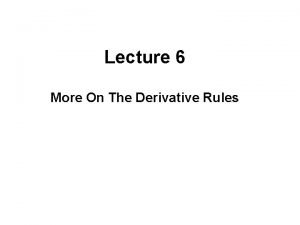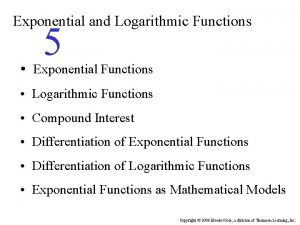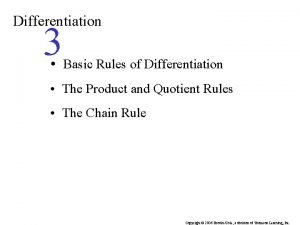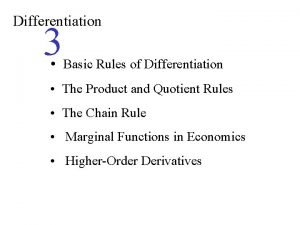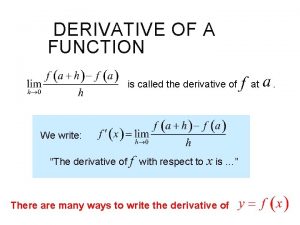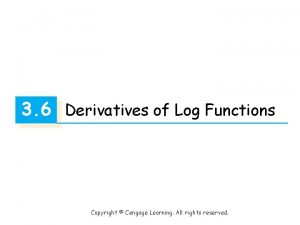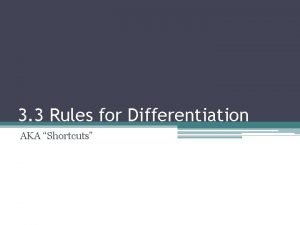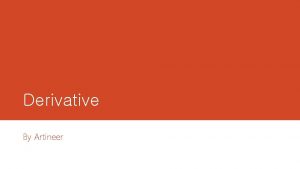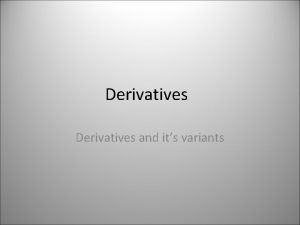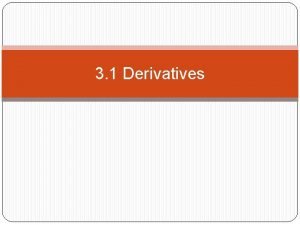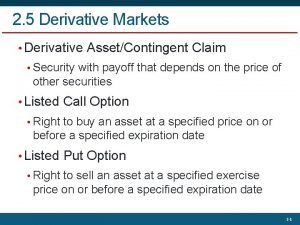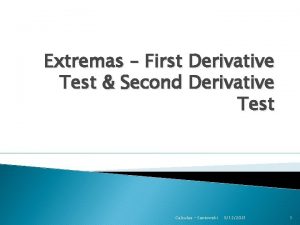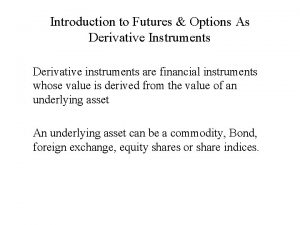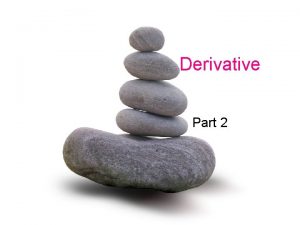Lecture 6 More On The Derivative Rules Derivative














- Slides: 14

Lecture 6 More On The Derivative Rules

Derivative Rules 1. If f is a function and c a constant then (cf) ‘ = c (f ‘) 2. If f and g are functions then (f+g) ‘ = f ‘ + g ‘ 3. (Leibnitz Rule) If f and g are functions then (fg) ’ = f ’ g + f g ’

Where Does Product Rule Come From? Recall key idea: For the purposes of studying a function f “near a” we can replace f by the function whose graph is the tangent line to f at x = a. If we have f and g we replace each by the tangent at x=a f -> f(a) + f ‘ (a)*(x-a) and g -> g(a) + g ‘(a)*(x-a) Then fg gets replaced by their product The derivative of this is Which when x = a is

More Derivative Rules 4. Quotient Rule 5. Power Rule ( )‘ = ( )‘ ‘

Power Rule Most often Encountered in Following Form Find f ‘ (x) if f ‘( x) =

Chain Rule 6. Power rule is a special case where

There are really only 3 rules 1. Additivity 2. Product rule 3. Chain rule The others come from these – Doesn’t hurt to remember the six.

Quotient Rule Comes from the Product Rule

Power Rule Comes from Chain Rule Want Let Then so we are looking for (p(f)) ’ By chain rule (p(f)) ’ = p ‘ (f)* f ‘ so ( )‘ ‘

Rules Apply to More than Formulas • The (red) graph of f(x) is given at right and the blue lines are tangent lines to the graph. Using information from the graph and the derivative rules estimate h’(3) where Solution: h ‘ (x) = (x ‘) f(x) + x f ‘ (x) = f(x) + x f ’(x) h ‘(3) = f(3) + 3 f ‘ (3). From the graph we estimate that f(3) = -3 and f ‘ (3) = -3/2 so we estimate h ‘ (3) = -3 + 3 (-3/2) = -15/2

Example Suppose f and g are functions such that f(5) = 4, f ‘ (5) = 7, g(5) = -3, g ‘ (5) = 2. What is the equation of the tangent line to the graph of h(x) = (fg) (x) at x = 5? Solution: (fg)(5) = f(5)(g(5) = (4)(-3) = -12. (fg)’ (x) = f ‘(x)g(x) + f(x)g ‘(x) so (fg)’(5) = f ‘ (5)g(5) + f(5)g ‘ (5) = 7(-3) + 4(2) = -13. y = (fg)(5) + (fg)’(5)(x-5) y = -12 -13(x-5)

Example Suppose f is a function such that f(8) = -3 and f ‘ (8) = 5. What is the slope of the tangent line to the graph of at x = 8? Sln:

Example Suppose f and g are functions such that f(7) = 2, f ‘(7) =11 g(3) = 7, and g ‘ (3) = 4. What is the equation of the tangent line to the graph of h(x) = f(g)(x) at x = 3? y – h(a) = h ‘ (a) ( x –a) y – h(3) = h ‘ (3) ( x – 3) y – f(g(3)) = f ‘ (g(3))g ’(3) ( x –a) y – f(7) = f ‘ (7)*4* ( x –a) y – 2 = 11*4* ( x –a) or y = 2 +44 ( x –a)

Example Suppose f is a function such that f(4) = 5 and f ‘(4) = 2. What is the slope of the tangent line at x = 2 to the graph of
 Lirik lagu more more more we praise you
Lirik lagu more more more we praise you More more more i want more more more more we praise you
More more more i want more more more more we praise you 01:640:244 lecture notes - lecture 15: plat, idah, farad
01:640:244 lecture notes - lecture 15: plat, idah, farad Derivative rules
Derivative rules Derivative of exponential
Derivative of exponential Differentiation formulas
Differentiation formulas Product rule derivatives examples
Product rule derivatives examples Derivative function
Derivative function Log derivative rules
Log derivative rules Derivative shortcut rules
Derivative shortcut rules Derivatives of inverse trigs
Derivatives of inverse trigs 5 apples in a basket riddle
5 apples in a basket riddle The more you study the more you learn
The more you study the more you learn Aspire not to have more but to be more
Aspire not to have more but to be more Examples of newton's first law
Examples of newton's first law



